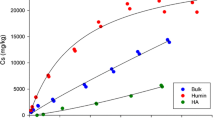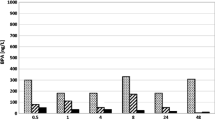Abstract
Adsorption to biomass is a key mechanism which results in the elimination of natural estrogens and their conjugates from sewage. Freundlich model showed that the adsorption capacities of estrone and 17β-estradiol to activated sludge were the highest at neutral pH. The lower capacities at pH 2 and 11.5 could be due to the competition of sludge adsorption sites by cations or electrostatic repulsion from particles of similar charges. The lowest adsorption capacity at pH 11.5 was attributable to electrostatic repulsion, and the highest capacity at pH 2 might be due to the increased sulfate adsorbability. For estrogen conjugates such as estrone-3-sulfate and 17β-estradiol-3-sulfate, adsorption performances were similar at pH 5, 7, and 9. It was observed that mean values of log K D were 2.78, 2.61, 1.67, and 1.94 l kg TSS−1; log K OM were 2.96, 2.79, 1.77, and 2.04 l kg VSS−1 and those of log K OC were 3.31, 3.12, 2.21, and 2.46 l kg OC−1 for estrone, 17β-estradiol, estrone-3-sulfate, and 17β-estradiol-3-sulfate, respectively.



Similar content being viewed by others
References
Andersen, H. R., Andersen, A. M., & Arnold, S. F. (1999). Comparison of short-term estrogenicity tests for identification of hormone-disrupting chemicals. Environmental Health Perspectives, 107(Supp 1), 89–108. doi:10.2307/3434476.
Byrne, S. V. (1991). Mechanisms of interaction between aniline, soil, soft solution, and soil microbes. Doctoral Dissertation, Department of Chemical and Biochemical Engineering, Rutgers University, New Brunswick, NJ
Chilvers, C., Pike, M. C., Forman, D., Fogelman, K., & Wadsworth, M. E. (1984). Apparent doubling of frequency of undescended testicles in England and Wales 1962–81. The Lancet, 2, 330–332.
Clara, M., Strenn, B., Saracevic, E., & Kreuzinger, N. (2004). Adsorption of bisphenol-A, 17β-estradiole and 17α-ethinylestradiole to sewage sludge. Chemosphere, 45, 843–851. doi:10.1016/j.chemosphere.2004.04.048.
Colborn, T., Dumanoski, D., & Myers, J. P. (1996). Our stolen future. New York: Dutton.
Conrad, A., Cadoret, A., Corteel, P., Leroy, P., & Block, J. C. (2006). Desorption of linear alkylbenzene sulfonate (LAS) and azoproteins by/from activated sludge flocs. Chemosphere, 62(1), 53–60. doi:10.1016/j.chemosphere.2005.04.014.
Desbrow, C., Routledge, E. J., Brighty, G. C., Sumpter, J. P., & Waldock, M. (1998). Identification of estrogenic chemicals in STW effluent 1. Chemical fractionation and in vitro biological screening. Environmental Science & Technology, 32, 1549–1558. doi:10.1021/es9707973.
Ganaye, V. A., Keiding, K., Vogel, T. M., Viriot, M. L., & Block, J. C. (1997). Evaluation of soil organic matter polarity by pyrene fluorescence spectrum variations. Environmental Science & Technology, 31, 2701–2706. doi:10.1021/es960705u.
Harris, C. A., Henttu, P., Parker, M. G., & Sumpter, J. P. (1997). The estrogenic activity of phthalate esters in vitro. Environmental Health Perspectives, 105, 802–811. doi:10.2307/3433697.
Harward, M. E., & Reisenauer, H. M. (1966). Movement and reactions of inorganic soil sulfur. Soil Science, 101, 326–325. doi:10.1097/00010694-196604000-00012.
Holm, L., Berg, C., Brunstrom, B., Ridderstrale, Y., & Brandt, I. (2001). Disrupted carbonic anhydrase distribution in the avian shell gland following in ovo exposure to estrogen. Archives of Toxicology, 75, 362–368. doi:10.1007/s002040100241.
Hildebrand, C., Londry, K. L., & Farenhorst, A. (2006). Sorption and desorption of three endocrine disrupters in soils. Environmental Science and Health Part B, 41(6), 907–921.
Hu, J. Y., Chen, X., Tao, G., & Kekred, K. (2007). Fate of endocrine disrupting compounds in membrane bioreactor systems. Environmental Science & Technology, 41, 4097–4102. doi:10.1021/es062695v.
Huang, C. H., & Sedlak, D. L. (2001). Analysis of estrogenic hormones in municipal wastewater effluent and surface water using enzyme linked immunosorbent assay and gas chromatography/tandem mass spectrometry. Environmental Toxicology and Chemistry, 20, 133–139. doi:10.1897/1551-5028(2001)020<0133:AOEHIM>2.0.CO;2.
Isobe, T., Serizawa, S., Horiguchi, T., Shibata, Y., Managaki, S., Takada, H., et al. (2006). Horizontal distribution of steroid estrogens in surface sediments in Tokyo Bay. Environmental Pollution, 144, 632–638. doi:10.1016/j.envpol.2006.01.030.
Jara, A., Violante, A., Pigna, M., & Mora, M. (2006). Mutual interaction of sulfate, oxalate, citrate and phosphate on synthetic and natural allophones. Soil Science Society of America Journal, 70, 337–346. doi:10.2136/sssaj2005.0080.
Jobling, S., Nolan, M., Tyler, C. R., Brighty, G., & Sumpter, J. P. (1998). Widespread sexual disruption in wild fish. Environmental Science & Technology, 32, 2498–2506. doi:10.1021/es9710870.
Jürgens, M.D., Johnson, A.C., & Williams, R.J. (1999). In fate and behavior of steroid oestrogens in rivers: A scoping study R&D technical report, no. P161. Environment Agency: Rotherham
Kimmel, C. A. (1993). Approaches to evaluating reproductive hazards and risks. Environmental Health Perspectives, 101(Suppl. 2), 137–143. doi:10.2307/3431387.
Kuyucak, N., & Volesky, B. (1988). Biosorbents for recovery of metals from industrial solutions. Biotechnology Letters, 10, 137–142. doi:10.1007/BF01024641.
Lai, K. M., Johnson, K. L., Scrimshaw, M. D., & Lester, J. N. (2000). Binding of waterborne steroid estrogens to solid phases in river and estuarine systems. Environmental Science & Technology, 34, 3890–3894. doi:10.1021/es9912729.
Layton, A. C., Gregory, B. W., Seward, J. R., Schultz, Y. W., & Sayler, G. S. (2000). Mineralization of steroidal hormones by biosolids in wastewater treatment systems in Tennessee U.S.A. Environmental Science & Technology, 34, 3925–3931. doi:10.1021/es9914487.
Martinson, L., & Alveteg, L. (2004). The importance of including the pH dependence of sulfate adsorption in a dynamic soil chemistry model. Water, Air, and Soil Pollution, 154, 349–356. doi:10.1023/B:WATE.0000022976.01342.2c.
Mikkelsen, L. H. (2003). Applications and limitations of the colloid titration method for measuring activated sludge surface charges. Water Research, 37, 2458–2466. doi:10.1016/S0043-1354(03)00021-6.
Nghiem, L. D., & Schäfer, A. I. (2002). Adsorption and transport of trace contaminant estrone in NF/RO membranes. Environmental Engineering Science, 19(6), 441–451. doi:10.1089/109287502320963427.
Panter, G. H., Thompson, R. S., Beresford, N., & Sumpter, J. P. (1999). Transformation of a non-oestrogenic steroid metabolite to an oestrogenically active substance by minimal bacterial activity. Chemosphere, 38, 3579–3596. doi:10.1016/S0045-6535(98)00572-4.
Preziosi, P. (1998). Natural and anthropogenic environmental oestrogens: the scientific basis for risk assessment endocrine disrupters as environmental signalers: An introduction. Pure and Applied Chemistry, 70, 1617–1631. doi:10.1351/pac199870091617.
Purdom, C. E., Hardiman, P. A., Bye, V. J., Eno, N. C., Tyler, C. R., & Sumpter, J. P. (1994). Oestrogenic effects of effluents from sewage treatment works. Chemistry and Ecology, 8, 275–285. doi:10.1080/02757549408038554.
Rajpert-De-Meyts, E., & Skakkeboek, N. E. (1993). The possible role of sex hormones in the development of testicular cancer. European Urology, 23, 54–61.
Reddy, S., Iden, C. R., & Brownawell, B. J. (2005). Analysis of steroid conjugates in sewage influent and effluent by liquid chromatography–tandem mass spectrometry. Analytical Chemistry, 77, 7032–7038. doi:10.1021/ac050699x.
Routledge, E. J., Sheahan, D., Desbrow, C., Brighty, G. C., Waldock, M., & Sumpter, J. P. (1998). Identification of estrogenic chemicals in STW effluent. 2. In vivo responses in trout and roach. Environmental Science & Technology, 32, 1559–1565. doi:10.1021/es970796a.
Schäfer, A. I., Mastrup, M., & Venkatesh, S. (2001). Estrogen removal using the MIEX and microfiltration hybrid process in wastewater recycling. Membrane bioreactors and hybrid systems workshop in Sydney, Australia (AWA).
Sirianuntapiboon, S., & Ungkaprasatcha, O. (2007). Removal of Pb2+ and Ni2+ by bio-sludge in sequencing batch reactor (SBR) and granular activated carbon-SBR (GAC-SBR) systems. Bioresource Technology, 98, 2749–2757. doi:10.1016/j.biortech.2006.09.032.
Sirianuntapiboon, S., Sadahiro, O., & Salee, P. (2007). Some properties of a granular activated carbon-sequencing batch reactor (GAC-SBR) system for treatment of textile wastewater containing direct dyes. Journal of Environmental Management, 85, 162–170. doi:10.1016/j.jenvman.2006.09.001.
Sparks, D. L. (1999). Kinetics and mechanisms of chemical reactions at the soil mineral/water interface. In D. L. Sparks (Ed.), Soil physical chemistry (pp. 135–191). Boca Raton: CRC.
Ternes, T. A., Andersen, H., Gilberg, D., & Bonerz, M. (2002). Determination of estrogens in sludge and sediments by liquid extraction and GC/MS/MS. Analytical Chemistry, 74, 3498–3504. doi:10.1021/ac015717z.
Turner, L. J., & Kramer, J. R. (1991). Sulfate ion binding on goethite and ematite. Soil Science, 152, 226–230. doi:10.1097/00010694-199109000-00010.
UK Environment Agency (UKEA). (1997). The identification and assessment of oestrogenic substances in sewage treatment works effluents. Rotherham: Environment Agency.
Yu, Z. Q., Xiao, B. H., Huang, W. L., & Peng, P. (2004). Sorption of steroid estrogens to soils and sediments. Environmental Toxicology and Chemistry, 23, 531–539. doi:10.1897/03-192.
Author information
Authors and Affiliations
Corresponding author
Rights and permissions
About this article
Cite this article
Chen, X., Hu, J. Adsorption of Natural Estrogens and Their Conjugates by Activated Sludge. Water Air Soil Pollut 206, 251–261 (2010). https://doi.org/10.1007/s11270-009-0102-0
Received:
Accepted:
Published:
Issue Date:
DOI: https://doi.org/10.1007/s11270-009-0102-0




